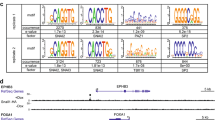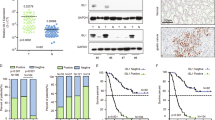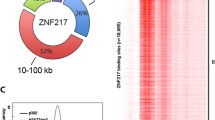Abstract
Background
ZEB2 is a transcriptional repressor that regulates epithelial-to-mesenchymal transition (EMT) through binding to bipartite E-box motifs in gene regulatory regions. Despite the abundant presence of E-boxes within the human genome and the multiplicity of pathophysiological processes regulated during ZEB2-induced EMT, only a small fraction of ZEB2 targets has been identified so far. Hence, we explored genome-wide ZEB2 binding by chromatin immunoprecipitation-sequencing (ChIP-seq) under endogenous ZEB2 expression conditions.
Methods
For ChIP-Seq we used an anti-ZEB2 monoclonal antibody, clone 6E5, in SNU398 hepatocellular carcinoma cells exhibiting a high endogenous ZEB2 expression. The ChIP-Seq targets were validated using ChIP-qPCR, whereas ZEB2-dependent expression of target genes was assessed by RT-qPCR and Western blotting in shRNA-mediated ZEB2 silenced SNU398 cells and doxycycline-induced ZEB2 overexpressing colorectal carcinoma DLD1 cells. Changes in target gene expression were also assessed using primary human tumor cDNA arrays in conjunction with RT-qPCR. Additional differential expression and correlation analyses were performed using expO and Human Protein Atlas datasets.
Results
Over 500 ChIP-Seq positive genes were annotated, and intervals related to these genes were found to include the ZEB2 binding motif CACCTG according to TOMTOM motif analysis in the MEME Suite database. Assessment of ZEB2-dependent expression of target genes in ZEB2-silenced SNU398 cells and ZEB2-induced DLD1 cells revealed that the GALNT3 gene serves as a ZEB2 target with the highest, but inversely correlated, expression level. Remarkably, GALNT3 also exhibited the highest enrichment in the ChIP-qPCR validation assays. Through the analyses of primary tumor cDNA arrays and expO datasets a significant differential expression and a significant inverse correlation between ZEB2 and GALNT3 expression were detected in most of the tumors. We also explored ZEB2 and GALNT3 protein expression using the Human Protein Atlas dataset and, again, observed an inverse correlation in all analyzed tumor types, except malignant melanoma. In contrast to a generally negative or weak ZEB2 expression, we found that most tumor tissues exhibited a strong or moderate GALNT3 expression.
Conclusions
Our observation that ZEB2 negatively regulates a GalNAc-transferase (GALNT3) that is involved in O-glycosylation adds another layer of complexity to the role of ZEB2 in cancer progression and metastasis. Proteins glycosylated by GALNT3 may be exploited as novel diagnostics and/or therapeutic targets.






Similar content being viewed by others
Abbreviations
- EMT:
-
Epithelial-to-mesenchymal transition
- ChIP:
-
Chromatin immunoprecipitation
- ChIP-Seq:
-
Chromatin immunoprecipitation-sequencing
- ChIP-qPCR:
-
Chromatin immunoprecipitation-quantitative polymerase chain reaction
- HCC:
-
Hepatocellular carcinoma
- RT-qPCR:
-
Real time- quantitative polymerase chain reaction
- ZEB2:
-
Zinc finger E-box binding homeobox 2
- GALNT3:
-
Polypeptide N-acetylgalactosaminyltransferase 3
References
T. Nagase, K.-i. Ishikawa, N. Miyajima, A. Tanaka, H. Kotani, N. Nomura, O. Ohara, Prediction of the coding sequences of unidentified human genes. IX. The complete sequences of 100 new cDNA clones from brain which can code for large proteins in vitro. DNA Res 5, 31–39 (1998)
K. Verschueren, J.E. Remacle, C. Collart, H. Kraft, B.S. Baker, P. Tylzanowski, L. Nelles, G. Wuytens, M.-T. Su, R. Bodmer, SIP1, a novel zinc finger/homeodomain repressor, interacts with Smad proteins and binds to 5′-CACCT sequences in candidate target genes. J Biol Chem 274, 20489–20498 (1999)
J.E. Remacle, H. Kraft, W. Lerchner, G. Wuytens, C. Collart, K. Verschueren, J.C. Smith, D. Huylebroeck, New mode of DNA binding of multi-zinc finger transcription factors: δEF1 family members bind with two hands to two target sites. EMBO J 18, 5073–5084 (1999)
J. Comijn, G. Berx, P. Vermassen, K. Verschueren, L. van Grunsven, E. Bruyneel, M. Mareel, D. Huylebroeck, F. Van Roy, The two-handed E box binding zinc finger protein SIP1 downregulates E-cadherin and induces invasion. Mol Cell 7, 1267–1278 (2001)
A.A. Postigo, J.L. Depp, J.J. Taylor, K.L. Kroll, Regulation of Smad signaling through a differential recruitment of coactivators and corepressors by ZEB proteins. EMBO J 22, 2453–2462 (2003)
L.A. van Grunsven, C. Michiels, T. Van de Putte, L. Nelles, G. Wuytens, K. Verschueren, D. Huylebroeck, Interaction between Smad-interacting protein-1 and the corepressor C-terminal binding protein is dispensable for transcriptional repression of E-cadherin. J Biol Chem 278, 26135–26145 (2003)
A.E. Sayan, T.R. Griffiths, R. Pal, G.J. Browne, A. Ruddick, T. Yagci, R. Edwards, N.J. Mayer, H. Qazi, S. Goyal, SIP1 protein protects cells from DNA damage-induced apoptosis and has independent prognostic value in bladder cancer. Proc Natl Acad Sci USA 106, 14884–14889 (2009)
G. Maeda, T. Chiba, M. Okazaki, T. Satoh, Y. Taya, T. Aoba, K. Kato, S. Kawashiri, K. Imai, Expression of SIP1 in oral squamous cell carcinomas: implications for E-cadherin expression and tumor progression. Int J Oncol 27, 1535–1541 (2005)
E. Rosivatz, I. Becker, K. Specht, E. Fricke, B. Luber, R. Busch, H. Höfler, K.-F. Becker, Differential expression of the epithelial-mesenchymal transition regulators snail, SIP1, and twist in gastric cancer. Am J Pathol 161, 1881–1891 (2002)
J. Caramel, E. Papadogeorgakis, L. Hill, G.J. Browne, G. Richard, A. Wierinckx, G. Saldanha, J. Osborne, P. Hutchinson, G. Tse, A switch in the expression of embryonic EMT-inducers drives the development of malignant melanoma. Cancer Cell 24, 466–480 (2013)
N. Wakamatsu, Y. Yamada, K. Yamada, T. Ono, N. Nomura, H. Taniguchi, H. Kitoh, N. Mutoh, T. Yamanaka, K. Mushiake, Mutations in SIP1, encoding Smad interacting protein-1, cause a form of Hirschsprung disease. Nat Genet 27, 369–370 (2001)
G. Verstappen, L.A. van Grunsven, C. Michiels, T. Van de Putte, J. Souopgui, J. Van Damme, E. Bellefroid, J. Vandekerckhove, D. Huylebroeck, Atypical Mowat–Wilson patient confirms the importance of the novel association between ZFHX1B/SIP1 and NuRD corepressor complex. Hum Mol Genet 17, 1175–1183 (2008)
C. Vandewalle, J. Comijn, B. De Craene, P. Vermassen, E. Bruyneel, H. Andersen, E. Tulchinsky, F. Van Roy, G. Berx, SIP1/ZEB2 induces EMT by repressing genes of different epithelial cell–cell junctions. Nucleic Acids Res 33, 6566–6578 (2005)
S.-Y. Lin, S.J. Elledge, Multiple tumor suppressor pathways negatively regulate telomerase. Cell 113, 881–889 (2003)
N. Ozturk, E. Erdal, M. Mumcuoglu, K.C. Akcali, O. Yalcin, S. Senturk, A. Arslan-Ergul, B. Gur, I. Yulug, R. Cetin-Atalay, Reprogramming of replicative senescence in hepatocellular carcinoma-derived cells. Proc Natl Acad Sci USA 103, 2178–2183 (2006)
J. Mejlvang, M. Kriajevska, C. Vandewalle, T. Chernova, A.E. Sayan, G. Berx, J.K. Mellon, E. Tulchinsky, Direct repression of cyclin D1 by SIP1 attenuates cell cycle progression in cells undergoing an epithelial mesenchymal transition. Mol Biol Cell 18, 4615–4624 (2007)
M. Kato, J. Zhang, M. Wang, L. Lanting, H. Yuan, J.J. Rossi, R. Natarajan, MicroRNA-192 in diabetic kidney glomeruli and its function in TGF-β-induced collagen expression via inhibition of E-box repressors. Proc Natl Acad Sci USA 104, 3432–3437 (2007)
T. Shirakihara, M. Saitoh, K. Miyazono, Differential regulation of epithelial and mesenchymal markers by δEF1 proteins in epithelial–mesenchymal transition induced by TGF-β. Mol Biol Cell 18, 3533–3544 (2007)
P.A. Gregory, A.G. Bert, E.L. Paterson, S.C. Barry, A. Tsykin, G. Farshid, M.A. Vadas, Y. Khew-Goodall, G.J. Goodall, The miR-200 family and miR-205 regulate epithelial to mesenchymal transition by targeting ZEB1 and SIP1. Nat Cell Biol 10, 593–601 (2008)
S.-M. Park, A.B. Gaur, E. Lengyel, M.E. Peter, The miR-200 family determines the epithelial phenotype of cancer cells by targeting the E-cadherin repressors ZEB1 and ZEB2. Genes Dev 22, 894–907 (2008)
S. Brabletz, T. Brabletz, The ZEB/miR-200 feedback loop—a motor of cellular plasticity in development and cancer? EMBO Rep 11, 670–677 (2010)
P.A. Gregory, C.P. Bracken, E. Smith, A.G. Bert, J.A. Wright, S. Roslan, M. Morris, L. Wyatt, G. Farshid, Y.-Y. Lim, An autocrine TGF-β/ZEB/miR-200 signaling network regulates establishment and maintenance of epithelial-mesenchymal transition. Mol Biol Cell 22, 1686–1698 (2011)
T. Acun, E. Oztas, T. Yagci, M.C. Yakicier, SIP1 is downregulated in hepatocellular carcinoma by promoter hypermethylation. BMC Cancer 11, 223 (2011)
E. Oztas, M.E. Avci, A. Ozcan, A.E. Sayan, E. Tulchinsky, T. Yagci, Novel monoclonal antibodies detect Smad-interacting protein 1 (SIP1) in the cytoplasm of human cells from multiple tumor tissue arrays. Exp Mol Pathol 89, 182–189 (2010)
C. Grandori, J. Mac, F. Siëbelt, D.E. Ayer, R.N. Eisenman, Myc-Max heterodimers activate a DEAD box gene and interact with multiple E box-related sites in vivo. EMBO J 15, 4344–4357 (1996)
A. Miquelajauregui, T. Van de Putte, A. Polyakov, A. Nityanandam, S. Boppana, E. Seuntjens, A. Karabinos, Y. Higashi, D. Huylebroeck, V. Tarabykin, Smad-interacting protein-1 (Zfhx1b) acts upstream of Wnt signaling in the mouse hippocampus and controls its formation. Proc Natl Acad Sci USA 104, 12919–12924 (2007)
A. Stryjewska, R. Dries, T. Pieters, G. Verstappen, A. Conidi, K. Coddens, A. Francis, L. Umans, W.F. van IJcken, G. Berx, Zeb2 regulates cell fate at the exit from epiblast state in mouse embryonic stem cells. Stem Cells 35, 611–625 (2017)
H. Yuzugullu, K. Benhaj, N. Ozturk, S. Senturk, E. Celik, A. Toylu, N. Tasdemir, M. Yilmaz, E. Erdal, K.C. Akcali, Canonical Wnt signaling is antagonized by noncanonical Wnt5a in hepatocellular carcinoma cells. Mol Cancer 8, 90 (2009)
M.F. Carey, C.L. Peterson, S.T. Smale, Chromatin immunoprecipitation (chip). Cold Spring Harb Protoc 2009, pdb. prot5279 (2009)
N. Gévry, S. Hardy, P.-É. Jacques, L. Laflamme, A. Svotelis, F. Robert, L. Gaudreau, Histone H2A. Z is essential for estrogen receptor signaling. Genes Dev 23, 1522–1533 (2009)
H. Li, R. Durbin, Fast and accurate short read alignment with Burrows–Wheeler transform. Bioinformatics 25, 1754–1760 (2009)
Y. Zhang, T. Liu, C.A. Meyer, J. Eeckhoute, D.S. Johnson, B.E. Bernstein, C. Nusbaum, R.M. Myers, M. Brown, W. Li, Model-based analysis of ChIP-Seq (MACS). Genome Biol 9, R137 (2008)
S. Gupta, J.A. Stamatoyannopoulos, T.L. Bailey, W.S. Noble, Quantifying similarity between motifs. Genome Biol 8, R24 (2007)
M.E. Avci, O. Konu, T. Yagci, Quantification of SLIT-ROBO transcripts in hepatocellular carcinoma reveals two groups of genes with coordinate expression. BMC Cancer 8, 392 (2008)
U. Burk, J. Schubert, U. Wellner, O. Schmalhofer, E. Vincan, S. Spaderna, T. Brabletz, A reciprocal repression between ZEB1 and members of the miR-200 family promotes EMT and invasion in cancer cells. EMBO Rep 9, 582–589 (2008)
F. Pontén, K. Jirström, M. Uhlen, The human protein atlas—a tool for pathology. J Pathol 216, 387–393 (2008)
J.P. Thiery, Epithelial–mesenchymal transitions in tumour progression. Nat Rev Cancer 2, 442–454 (2002)
A. Sathyanarayanan, K.S. Chandrasekaran, D. Karunagaran, microRNA-145 modulates epithelial-mesenchymal transition and suppresses proliferation, migration and invasion by targeting SIP1 in human cervical cancer cells. Cell Oncol 40, 119–131 (2017)
S. Bugide, V.K. Gonugunta, V. Penugurti, V.L. Malisetty, R.K. Vadlamudi, B. Manavathi, HPIP promotes epithelial-mesenchymal transition and cisplatin resistance in ovarian cancer cells through PI3K/AKT pathway activation. Cell Oncol 40, 133–144 (2017)
A. Fortunato, The role of hERG1 ion channels in epithelial-mesenchymal transition and the capacity of riluzole to reduce cisplatin resistance in colorectal cancer cells. Cell Oncol 40, 367–378 (2017)
G. Xu, L. Zhang, A. Ma, Y. Qian, Q. Ding, Y. Liu, B. Wang, Z. Yang, Y. Liu, SIP1 is a downstream effector of GADD45G in senescence induction and growth inhibition of liver tumor cells. Oncotarget 6, 33636 (2015)
P. Tylzanowski, K. Verschueren, D. Huylebroeck, F.P. Luyten, Smad-interacting protein 1 is a repressor of liver/bone/kidney alkaline phosphatase transcription in bone morphogenetic protein-induced osteogenic differentiation of C2C12 cells. J Biol Chem 276, 40001–40007 (2001)
S.A. Mani, W. Guo, M.-J. Liao, E.N. Eaton, A. Ayyanan, A.Y. Zhou, M. Brooks, F. Reinhard, C.C. Zhang, M. Shipitsin, The epithelial-mesenchymal transition generates cells with properties of stem cells. Cell 133, 704–715 (2008)
N.E. Renthal, C.-C. Chen, C.W. Koriand’r, R.D. Gerard, J. Prange-Kiel, C.R. Mendelson, miR-200 family and targets, ZEB1 and ZEB2, modulate uterine quiescence and contractility during pregnancy and labor. Proc Natl Acad Sci USA 107, 20828–20833 (2010)
K. Yoshiura, Y. Kanai, A. Ochiai, Y. Shimoyama, T. Sugimura, S. Hirohashi, Silencing of the E-cadherin invasion-suppressor gene by CpG methylation in human carcinomas. Proc Natl Acad Sci USA 92, 7416–7419 (1995)
E.P. Bennett, U. Mandel, H. Clausen, T.A. Gerken, T.A. Fritz, L.A. Tabak, Control of mucin-type O-glycosylation: a classification of the polypeptide GalNAc-transferase gene family. Glycobiology 22, 736–756 (2011)
S.R. Stowell, T. Ju, R.D. Cummings, Protein glycosylation in cancer. Annu Rev Pathol Mech 10, 473–510 (2015)
T. Liu, S. Zhang, J. Chen, K. Jiang, Q. Zhang, K. Guo, Y. Liu, The transcriptional profiling of glycogenes associated with hepatocellular carcinoma metastasis. PLoS One 9, e107941 (2014)
K. Shibao, H. Izumi, Y. Nakayama, R. Ohta, N. Nagata, M. Nomoto, K. Matsuo, Y. Yamada, K. Kitazato, H. Itoh, Expression of UDP-N-acetyl-α-D-galactosamine–polypeptide galNAc N-acetylgalactosaminyl transferase-3 in relation to differentiation and prognosis in patients with colorectal carcinoma. Cancer 94, 1939–1946 (2002)
S. Kitada, S. Yamada, A. Kuma, S. Ouchi, T. Tasaki, A. Nabeshima, H. Noguchi, K. Wang, S. Shimajiri, R. Nakano, Polypeptide N-acetylgalactosaminyl transferase 3 independently predicts high-grade tumours and poor prognosis in patients with renal cell carcinomas. Br J Cancer 109, 472–481 (2013)
Y. Harada, H. Izumi, H. Noguchi, A. Kuma, Y. Kawatsu, T. Kimura, S. Kitada, H. Uramoto, K.-Y. Wang, Y. Sasaguri, Strong expression of polypeptide N. Tumour Biol 37, 1357–1368 (2016)
Z.-Q. Wang, M. Bachvarova, C. Morin, M. Plante, J. Gregoire, M.-C. Renaud, A. Sebastianelli, D. Bachvarov, Role of the polypeptide N-acetylgalactosaminyltransferase 3 in ovarian cancer progression: possible implications in abnormal mucin O-glycosylation. Oncotarget 5, 544–560 (2014)
Y. Fan, R. Bi, M.J. Densmore, T. Sato, T. Kobayashi, Q. Yuan, X. Zhou, R.G. Erben, B. Lanske, Parathyroid hormone 1 receptor is essential to induce FGF23 production and maintain systemic mineral ion homeostasis. FASEB J 30, 428–440 (2016)
C.A. Yoshida, T. Kawane, T. Moriishi, A. Purushothaman, T. Miyazaki, H. Komori, M. Mori, X. Qin, A. Hashimoto, K. Sugahara, Overexpression of Galnt3 in chondrocytes resulted in dwarfism due to the increase of mucin-type O-glycans and reduction of glycosaminoglycans. J Biol Chem 289, 26584–26596 (2014)
H. Izumi, O. Ryo, G. Nagatani, I. Tomoko, Y. Nakayama, M. Nomoto, K. Kohno, p300/CBP-associated factor (P/CAF) interacts with nuclear respiratory factor-1 to regulate the UDP-N-acetyl-alpha-d-galactosamine: polypeptide N-acetylgalactosaminyltransferase-3 gene. Biochem J 373, 713–722 (2003)
K.A. Maupin, A. Sinha, E. Eugster, J. Miller, J. Ross, V. Paulino, V.G. Keshamouni, N. Tran, M. Berens, C. Webb, Glycogene expression alterations associated with pancreatic cancer epithelial-mesenchymal transition in complementary model systems. PLoS One 5, e13002 (2010)
Acknowledgements
The study was funded by the Scientific and Technical Research Council of Turkey (TUBITAK) grant 111S484 (to T.Y.).
Author information
Authors and Affiliations
Contributions
T.Y., A.E.S. and P.B-E. designed the study. P.B-E., M.C., I.Y-C. and G.O. performed the experiments. P.B-E., N.T. and T.Y. analyzed and interpreted the data. T.Y., A.E.S. and P.B-E. wrote the manuscript. All authors read and approved the final manuscript.
Corresponding author
Ethics declarations
Competing interests
The authors declare that they have no conflict of interest.
Electronic supplementary material
Supplementary Fig. S1
(PDF 460 kb)
Supplementary Fig. S2
(PDF 523 kb)
Supplementary Fig. S3
(PDF 798 kb)
Supplementary Fig. S4
(PDF 360 kb)
Supplementary Table 1
(XLS 48 kb)
Rights and permissions
About this article
Cite this article
Balcik-Ercin, P., Cetin, M., Yalim-Camci, I. et al. Genome-wide analysis of endogenously expressed ZEB2 binding sites reveals inverse correlations between ZEB2 and GalNAc-transferase GALNT3 in human tumors. Cell Oncol. 41, 379–393 (2018). https://doi.org/10.1007/s13402-018-0375-7
Accepted:
Published:
Issue Date:
DOI: https://doi.org/10.1007/s13402-018-0375-7




